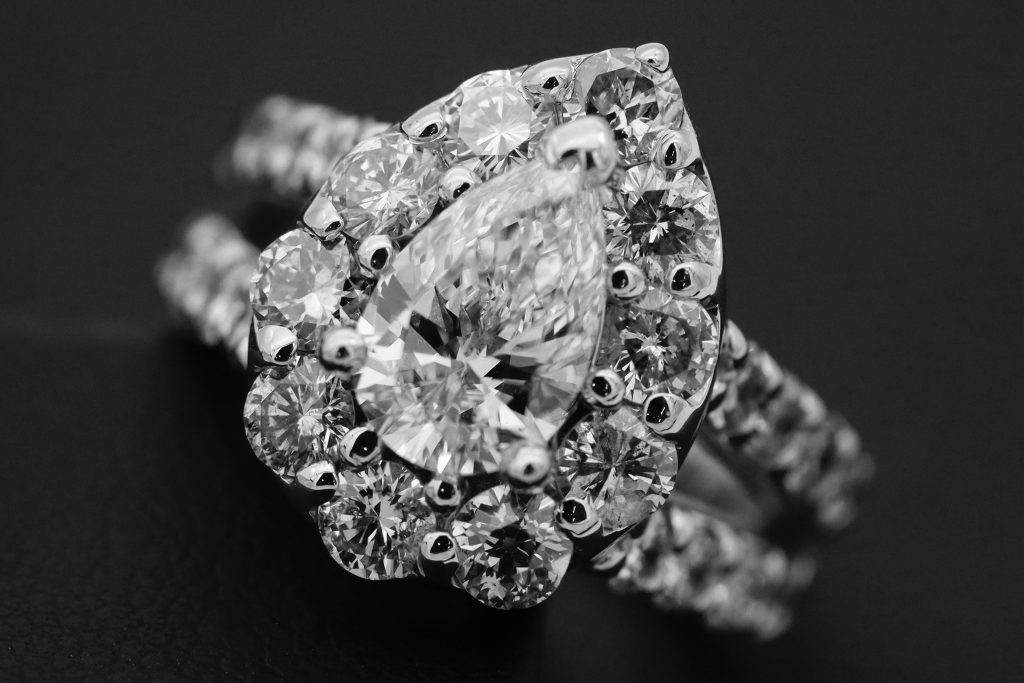Diamond rings can be classified in many ways, but the classifications used most often are by design, type of setting, shape, and cut of the diamonds, and metal used to make the band. In this brief and useful guide, we break down different attributes and types of diamond rings.
Are you looking to sell your diamond ring? Contact us today for a free consultation.
Number of Stones and Design
Solitaire Rings
Honoring its namesake, these rings are made to showcase a single diamond. In this setting, stones are usually held by prongs. Other mountings such as the bezel or tension setting are also used. Solitaire diamond rings are designed to highlight the beauty of a diamond. While the brilliant round diamond is the most popular stone for solitaire engagement rings, any diamond shape is a beautiful centerpiece in this classic setting.
Rings with Side Stones
These have one center diamond surrounded by smaller diamonds.
One of the most popular variations of side-stone rings is the three-stone ring. These have one center diamond and two stones on each of its sides. A three-stone engagement ring setting is meant to showcase a trio of stones, often three diamonds balanced visually on the band.
Pave Rings
These are studded with small diamonds attached to the band with tiny metal prongs that often look like droplets of metal. This ring is clasically made with small pave-set diamonds. It could also feature a bigger single stone, a center diamond with side stones, called a halo. This is a popular style because the diamond halo maximizes the visual impact of the center stone.
Want to learn more about how diamonds are valued? Read Westlake’s guide here.
Type of Setting
Setting refers to how gemstones are set, or mounted, into a metal band. The ring setting is meant to highlight the beauty of an engagement diamond. Style refers to the overall design aesthetic that the ring setting helps create. These can be solitaire, halo, or three-stone. There are different types of settings used to hold a diamond in a ring, and here are the most popular ones:
Prong Settings
The most common type of engagement ring setting is the prong setting. This setting features slim metal arms that securely cradle the diamond at the girdle. These hold the diamond with metal projections, usually four to six, although settings with more prongs are also made.
Bezel Settings
A popular setting for diamond wedding bands, the bezel setting features a metal rim that protects the edges of a gemstone, surrounding the stone either fully or partially. Bezel-set engagement rings are defined by a flat surface that exposes only the crown, or top, of the diamond. Settings, where only part of the stone’s outer edge is held by a metal band, are referred to as partial bezel settings.
Bead Settings
In this type of setting, small round pieces of metal are raised from the surface and used as prongs to secure each gemstone. This setting often features accent stones on the band.
Channel Settings
As the name suggests, this setting hold diamonds in a channel made in the ring’s band using two parallel walls of metal inside the band.
Tension Settings
In a tension setting, opposing directions of pressure are used to hold a stone. This ensures that it appears suspended in place. This tension creates the illusion of a diamond floating in midair, and allows for better light on the stone by not using prongs, bezels, or any other type of mounting device.
Burnish Settings
In a burnish setting, stones are nestled in hollows within the band. These are secured in place by burnishing (pressing) the metal to cover each gem’s girdle.
Are you looking to sell your diamonds or diamond jewelry? Contact Westlake Gold for a free consultation today.
Diamond Shape and Cut
Diamond Shape
This refers to the profile of the stone, while the term “diamond cut” is more specific and is used to refer to the number, shape, and alignment of the stone’s facets. There are many of these to choose from, but we compiled the most popular:
Round Diamonds
These are by far the most popular. The classic round cut was designed to maximize the stone’s brilliance, which surpasses that of stones with other cuts. Round diamonds will typically give you more flexibility in terms of balancing cut, color, and clarity grades while still getting the sparkle you want.
Oval Cuts
These are also popular, although not as much as round ones. There are other popular cuts that are derived from the oval cut: the marquise cut (whose two ends are sharp instead of rounded), the pear cut (basically an oval cut with one sharp end), and the heart cut (an oval cut with one sharp end and a cleft on the opposite rounded end).
Rectangular Cuts
These include the popular princess cut, the emerald cut (a rectangular cut with truncated corners) and the Asscher cut (a square emerald cut), the cushion cut (with rounded instead of sharp or cut corners), and the radiant cut.
Triangular Cut
This is a classic cut referred to as trillion cut, or trilliant cut. The sides of this cut’s triangular profile can be straight or slightly rounded.
Other factors that can attribute to a diamond ring’s classification are the metal type and size of the diamonds themselves.
Contact us today and get a free cleaning for your diamond jewelry and a free consultation.




